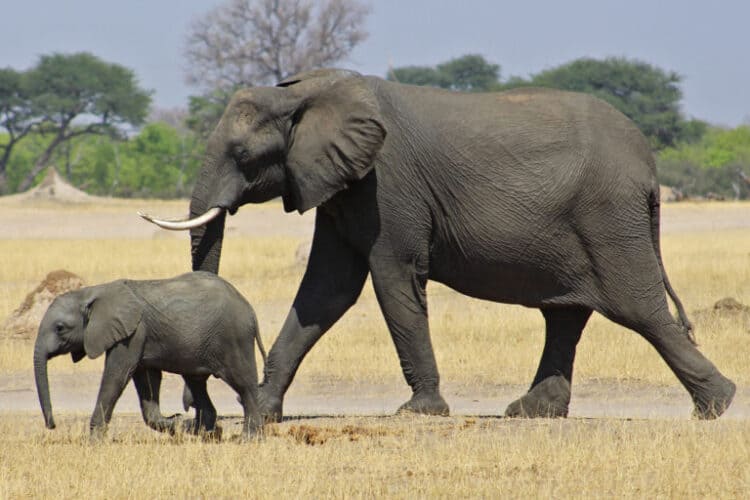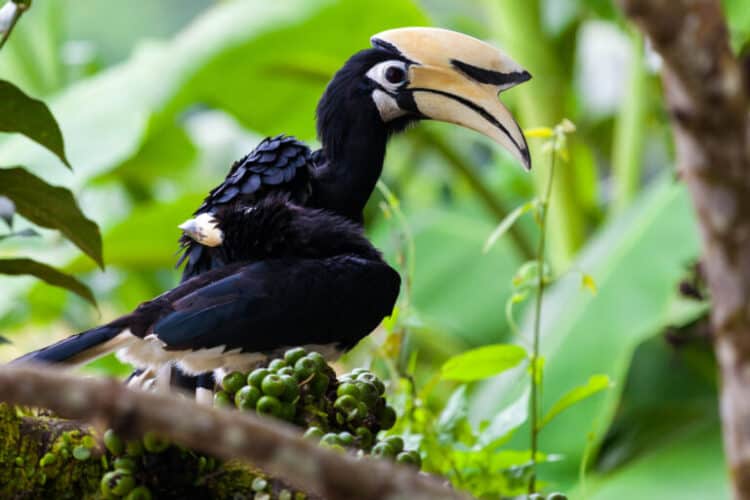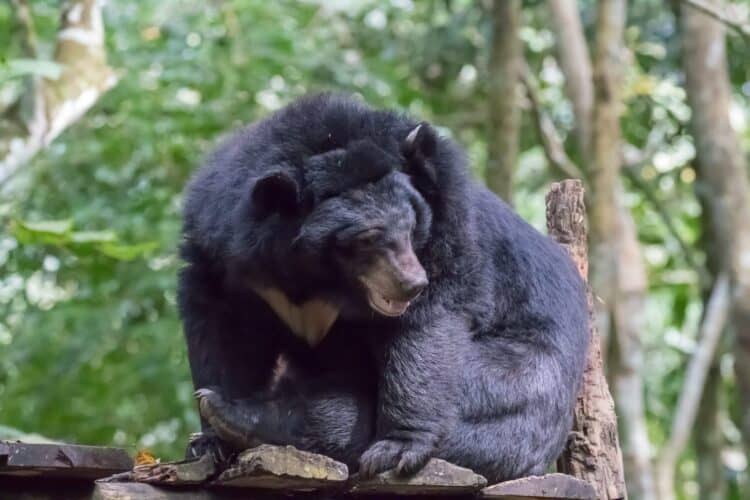According to Zimbabwe authorities, poachers have killed a total of 80 elephants by poisoning them with cyanide, a highly toxic industrial chemical, during various incidents in recent months.
First, 11 elephants were killed in Hwange National Park and 3 in Matusadona National Park. On October 26, the parks authority announced that another 22 had been poisoned and killed in Hwange. A week later, it was reported that cyanide had taken the lives of 26 in the park. And during the past three weeks, more cyanide deaths were found in Mana Pools, Chizarira, and Gonarezhou National Parks.
A court in Hwange has sentenced three men to a range of from seven months to 10 years in prison in connection with the cyanide poisonings in the park. Raids conducted by the police and parks units on November 22 yielded other arrests, with charges including illegal possession of ivory, ammunition, and cyanide concentrate.

Two men, who were implicated in cyanide killings in Hwange in 2013, also appeared in court yesterday. They’re accused of possessing 37 kilograms of ivory that they allegedly took from dead elephants in the most recent cyanide poisonings. One of the men used to work for the Parks and Wildlife Management Authority.
Elephant poaching has been on the rise in Zimbabwe, and cyanide is becoming an increasingly common way to kill. It’s cheap and quiet. Poachers have laced salt licks with the cyanide and poured the chemical into watering holes. They’ve even baited oranges with it.
But who’s using it? And where does it come from? A closer look at Zimbabwe’s hazardous substance laws shows a thriving black market for cyanide, thanks to a weak inventory control system and lack of tracking once it leaves the primary seller’s possession.
In early November, Oppah Muchinguri, Zimbabwe’s minister of water, climate and environment, told the Sunday Mail, a weekly paper owned by the government, that investigations into the cyanide poisonings had revealed that poaching syndicates smuggle cyanide into the country from Zambia and South Africa.Picture of rangers and dead elephant in zimbabwe

She also said that the probe has been expanded to include park employees, seven of whom have already been arrested in connection with the earlier cyanide killings. Two local police officers have also been arrested.
The latest spate of killings, splashed across papers from Zimbabwe to the United States, raise concern about a possible resumption in the use of the chemical. Two years ago, more than 300 elephants were killed with cyanide by well-organized poaching syndicates operating from the capital, Harare, and Bulawayo, the country’s second city. According to investigative sources within the parks authority, Chinese ivory traffickers in Harare were implicated.
Zimbabwe has more than 83,000 elephants, according to government estimates, most of them in Hwange National Park and along the Zambezi Valley. Elephant poaching has been on the rise. A 2014 report, the National Survey for Elephants in Zimbabwe, said that the number of elephants in the Zambezi Valley had fallen from 19,000 in 2001 to 13,000—a 40 percent drop.
More Zimbabweans were arrested for elephant poaching than foreigners in 2012—mainly South Africans but also Zambians, Congolese, and Botswanans, according to a report released by safari operators in the Hwange and Gwayi areas. Several Chinese citizens have also been arrested for alleged involvement in ivory trafficking to Asia.
What Is Cyanide?
Cyanide is a fast-acting, potentially deadly chemical. It exists in two states: as the colorless gases hydrogen cyanide and cyanogen chloride or in crystal form as sodium cyanide or potassium cyanide.
The chemical is used for everything from making paper, textiles, and plastics to mining gold—an important application in Zimbabwe. Miners use cyanide concentrate to catalyze the separation of pure gold from bulk ores during the chemical purification process. In gas form, it’s used to kill pests in buildings and ships. It has also been used as a weapon of war.
Cyanide kills the body’s cells by starving them of oxygen. In mammals, the poison is most harmful to the heart and brain—organs that depend heavily on oxygen supplies.
Elephants, according to Dave Dell, of Friends of Hwange, an elephant welfare group working in the park, are especially vulnerable to mass killings because they move together in large groups, sharing the same salt licks and water sources.
“Usually they don’t get more than 100 meters” after taking the poison, Dell told the Los Angeles Times. “The suffering is horrible. They get weak very quickly and collapse.”
Zimbabwe’s Cyanide Black Market
There’s no way of knowing where cyanide goes to see whether miners are using or proliferating it.
Tshinga Dube, Organization for the Prohibition of Chemical Weapons
Under Zimbabwe’s Hazardous Substance Act, cyanide can only be sold by accredited chemical substance dealers to customers in the mining and chemical industry. The customers, mostly gold miners, are then required to produce written proof that they’re authorized to handle and use it.
These accredited chemical substance dealers must have valid permits from the Ministry of Mines and Mining Development.
The Zimbabwe Defence Forces also hold large quantities of military grade mercury, cyanide, and hydrogen gas compounds. The army is allowed to acquire and use cyanide concentrate for specified military purposes.
But dealers don’t always follow the law.
“In some cases, dealers divert their legal stocks for sale in the black market,” said Tshinga Dube, chairman of Zimbabwe’s National Chapter of the Organization for the Prohibition of Chemical Weapons, an inter-ministerial committee tasked with monitoring the control and use of chemical and hazardous substances in the industrial, agricultural, and mining industries.
In other cases, it appears that cyanide is being stolen or illegally sold from the mines themselves, after it has been purchased legally from dealers. “Many mines are unable to secure their stocks, and some people in positions of responsibility steal and sell cyanide to unlicensed people,” Dube said.
Miners are required to obtain a license and be subject to inspections in order to ensure the substance is not re-sold or misused, said Wellington Takavarasha, the CEO of the Zimbabwe Miners Federation, a union representing small-scale gold miners. “When a miner buys cyanide, the Environmental Management Agency inspects the receipts and insists on seeing where it will be kept and used.”
Takavarasha, like Dube, said the substance needs more stringent monitoring. “There’s a need for a multi-stakeholder approach to keep track of the sources,” Takavarasha told the Sunday News.

One small-scale gold miner, who requested anonymity for fear of retribution by the miners union, agrees. “What the law says and what people do is another thing,” he said.
He has three mines in the Inyathi gold belt, about 30 miles north of Bulawayo, and although he’s been in the gold mining business for six years, he’s never been personally certified for any of the thousands of tons of cyanide concentrate he’s used to keep the mines running.
“The mines I operate are registered in the name of a local indigenous consortium,” he said. The consortiums enjoy certain legal exemptions and waivers that make it less financially burdensome for small-scale miners to acquire mining equipment and chemicals.
“The consortium holds the license, so the consortium acquires and distributes inputs like cyanide concentrate to members,” he explained. “How the member use it, or who they share it with or sell it to afterwards is their business. That way cyanide from registered mines gets sold to illegal gold panners who also use it to process ores.”
That, he said, is just the beginning. “Gold panners then proliferate it by selling to each other in small quantities, and as a result, every household with a gold panner has a quantity of illegally acquired cyanide from time to time.”
After the highly publicized 2013 cyanide killings in Hwange, the miner said, “many people realized that [cyanide] pays a lot more than its gold purification value if sold to poachers, and they now buy it for resale to poaching syndicates around Hwange.
“We know of many middlemen who come from Hwange to buy cyanide from miners. Anyone can get cyanide as long as they can pay $50 or more per 5-kilogram bag of concentrate. Poachers buy the same measure for $100.”
Tracking Cyanide
A big part of the problem, Dube said, is that cyanide in Zimbabwe isn’t tracked. “There’s no way of knowing where cyanide goes from the dealerships and no follow-ups to see whether the miners are using or proliferating it.”
Dube believes that the only way to stop poachers from getting hold of cyanide is to monitor gold miners’ use of it and create a tracking system to follow it from port of entry to end user.
Local police don’t have the proper scientific training to monitor the substance. “Only the Zimbabwe Revenue Authority, which keeps national import records, could be the starting point for monitoring,” he said. “The authority is better positioned to create a database of importers and registers of the quantities they order.”
It remains to be seen what will be done to prevent more cyanide killings. As Muchinguri, the environment minister, told the Sunday Mail, “What I want to make clear is that we are going to change a lot of things in the wildlife industry. There are going to be serious reforms. We are going to factor in all issues, starting from the bosses down to the rangers. We are therefore going to conduct an audit to get to the bottom of the matter. It is clear that the system is not watertight.”
Dube said that to improve accountability, the Zimbabwe chapter of Organization for the Prohibition of Chemical Weapons is leading other government agencies in the creation of a comprehensive database of companies that import and use cyanide.
The Zimbabwe Defence Forces has also been deployed to Hwange, Matusadona, Chizarira, Gonarezhou, and Mana Pools National Park to crack down on poaching.
This article was first published by National Geographic on 24 Nov 2015.






Leave a Reply